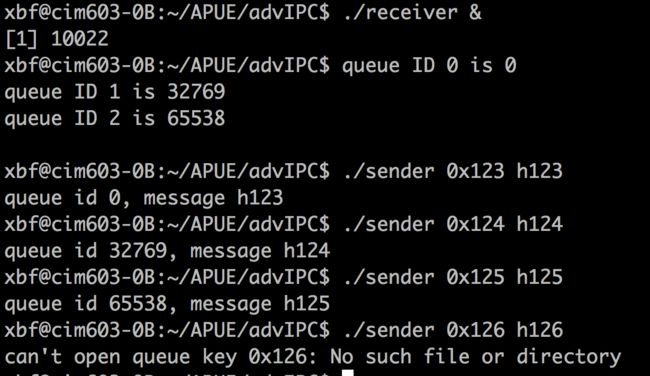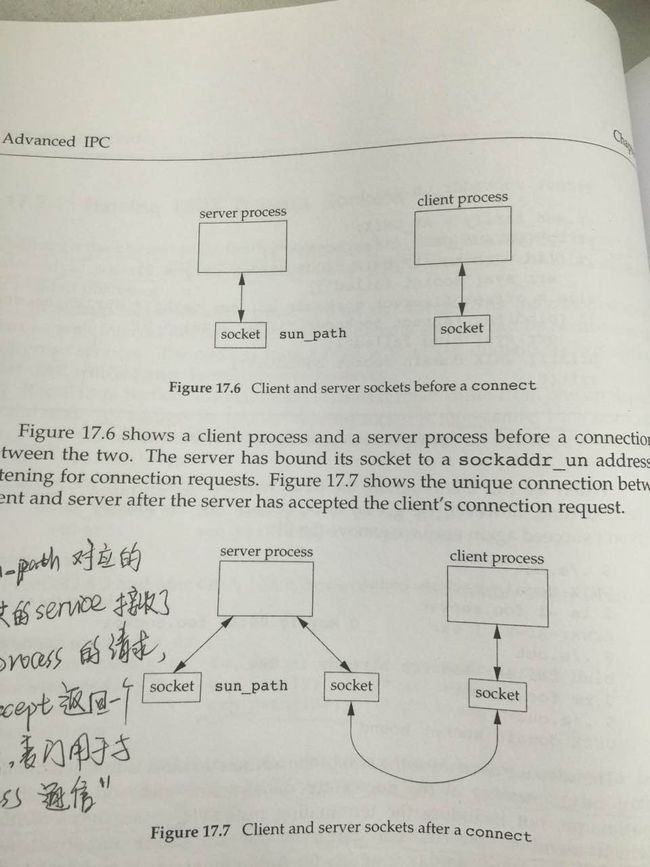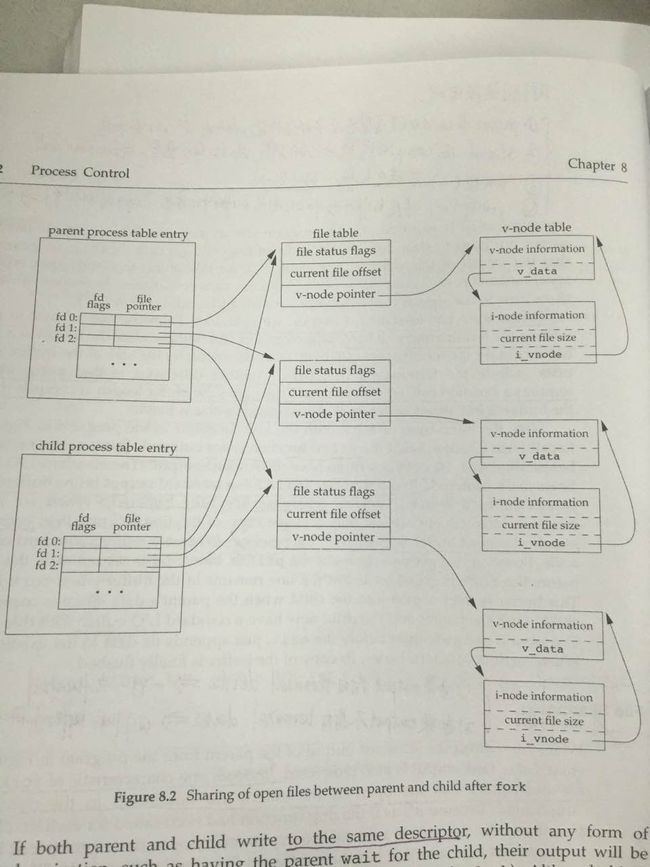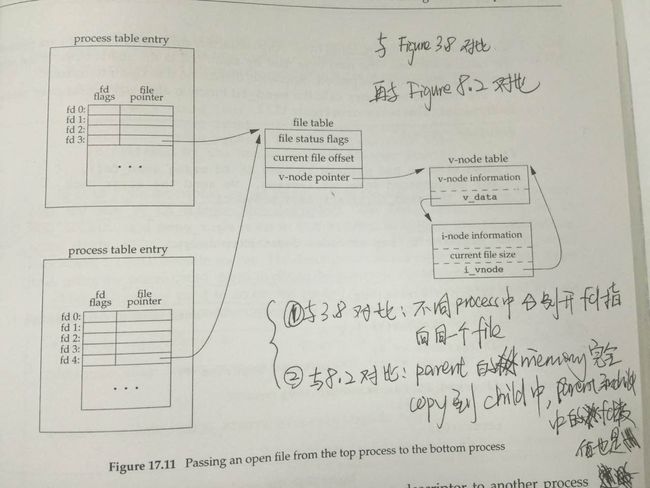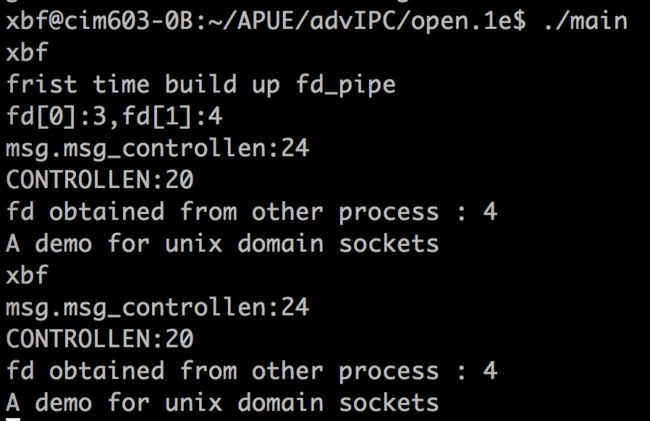【APUE】Chapter17 Advanced IPC & sign extension & 结构体内存对齐
17.1 Introduction
这一章主要讲了UNIX Domain Sockets这样的进程间通讯方式,并列举了具体的几个例子。
17.2 UNIX Domain Sockets
这是一种特殊socket类型,主要用于高效的IPC,特点主要在于高效(因为省去了很多与数据无关的格式的要求)。
int socketpair(int domain, int type, int protocol, int sockfd[2]) 这个函数用于构建一对unix domain sockets;并且与之前的pipe函数不同,这里构建fd都是full-duplex的。
下面列举一个poll + message queue + 多线程 的例子。
为什么要举上面的例子?因为没办法直接用poll去管理多个message queue。
message queue在unix系统中有两种标示方法:1. 全局用一个key 2. 进程内部用一个identifier
而poll关注的对象只能是file descriptor;所以,用unix domain sockets作为二者的桥梁。
例子包含两个部分,reciver端和sender端。
reciver挂起来几个message queue,每个queue单独开一个线程去处理;主线程跟每个queue线程的关联方式就是unix domain sockets。代码如下:
1 #include "../apue.3e/include/apue.h" 2 #include <sys/poll.h> 3 #include <pthread.h> 4 #include <sys/msg.h> 5 #include <sys/socket.h> 6 7 #define NQ 3 8 #define MAXMSZ 512 9 #define KEY 0x123 10 11 struct threadinfo{ 12 int qid; 13 int fd; 14 }; 15 16 struct mymesg{ 17 long mtype; 18 char mtext[MAXMSZ]; 19 }; 20 21 void * helper(void *arg) 22 { 23 int n; 24 struct mymesg m; 25 struct threadinfo *tip = arg; 26 27 for(; ;) 28 { 29 memset(&m, 0, sizeof(m)); 30 if ((n = msgrcv(tip->qid, &m, MAXMSZ, 0, MSG_NOERROR))<0) { 31 err_sys("msgrcv error"); 32 } 33 /*来自一个消息队列的内容 就特定的file desrciptor中*/ 34 if (write(tip->fd, m.mtext, n)<0) { 35 err_sys("write error"); 36 } 37 } 38 } 39 40 int main(int argc, char *argv[]) 41 { 42 int i, n, err; 43 int fd[2]; 44 int qid[NQ]; /*message queue在process内部的identifier*/ 45 struct pollfd pfd[NQ]; 46 struct threadinfo ti[NQ]; 47 pthread_t tid[NQ]; 48 char buf[MAXMSZ]; 49 50 /*给每个消息队列设定处理线程*/ 51 for (i=0; i<NQ; i++) { 52 /*返回消息队列的identifier 类似file descriptor*/ 53 if ((qid[i] = msgget((KEY+i), IPC_CREAT|0666))<0) { 54 err_sys("msgget error"); 55 } 56 printf("queue ID %d is %d\n", i, qid[i]); 57 /*构建unix domain sockets*/ 58 if (socketpair(AF_UNIX, SOCK_DGRAM, 0, fd)<0) { 59 err_sys("socketpair error"); 60 } 61 pfd[i].fd = fd[0]; /*main线程把住fd[0]这头*/ 62 pfd[i].events = POLLIN; /*有data要去读*/ 63 /* qid[i]在同一个process都可以用来表示同一个message queue */ 64 ti[i].qid = qid[i]; /*在每个线程中记录要处理的消息队列的id*/ 65 ti[i].fd = fd[1]; /*每个队列的线程把住fd[1]这头*/ 66 /*为每个消息队列创建一个处理线程 并将对应的threadinfo参数传入线程*/ 67 if ((err = pthread_create(&tid[i], NULL, helper, &ti[i]))!=0) { 68 err_exit(err, "pthread_create error"); 69 } 70 } 71 72 for (;;) { 73 /*一直轮询着 直到有队列可以等待了 再执行*/ 74 if (poll(pfd, NQ, -1)<0) { 75 err_sys("poll error"); 76 } 77 /*由于能进行到这里 则一定是有队列ready了 找到所有ready的队列*/ 78 for (i=0; i<NQ; i++) { 79 if (pfd[i].revents & POLLIN) { /*挑出来所有满足POLLIN条件的*/ 80 if ((n=read(pfd[i].fd, buf, sizeof(buf)))<0) { 81 err_sys("read error"); 82 } 83 buf[n] = 0; /* 这个末尾赋'\0'是必要的 因为接下来要执行printf*/ 84 printf("queue id %d, message %s\n",qid[i],buf); 85 } 86 } 87 } 88 exit(0); 89 }
sender端,用command-line argument的方式读入message的外部key,以及写入message queue的数据,具体代码如下:
#include "../apue.3e/include/apue.h" #include <sys/msg.h> #define MAXMSZ 512 struct mymesg{ long mtype; char mtext[MAXMSZ]; }; int main(int argc, char *argv[]) { key_t key; long qid; size_t nbytes; struct mymesg m; if (argc != 3) { fprintf(stderr, "usage: sendmsg KEY message\n"); exit(1); } key = strtol(argv[1], NULL, 0); if ((qid = msgget(key,0))<0) { err_sys("can't open queue key %s", argv[1]); } memset(&m, 0, sizeof(m)); strncpy(m.mtext, argv[2], MAXMSZ-1); nbytes = strlen(m.mtext); m.mtype = 1; if (msgsnd(qid, &m, nbytes, 0)<0) { err_sys("can't send message"); } exit(0); }
执行结果如下:
分析:
(1)unix socket domain在上述代码中的好处主要是方便了多个message queue的管理
(2)引入unix socket domain虽然带来了方便,但也在reciver中引入了两次额外的cost:一个是line34的write,向unix domain socket多写了一次;一个是line80的read,从unix domain socket多读了一次。如果这种cost在可接受范围内,那么unix socket domain就可以应用。
17.2.1 Naming UNIX Domain Sockets
上面介绍的这种socketpair的方式构造unix domain sockets,输出是几个fd,因此只能用于有亲属关系的process中。
如果要unrelated process之间用unix domain sockets通信,得从外面process能找到这个unix domain socket。
struct sockaddr_un{
sa_family_t sun_family; /*AF_UNIX*/
char sun_path[108]; /*pathname*/
}
这个结构体可以用来被构造成一个“可以被外面process找到的”的unix domain socket的地址,类似于“ip+port”的作用。
具体需要如下三个步骤的操作:
(1)fd = socket(AF_UNIX, SOCK_STREAM, 0) // 产生unix domain socket
(2)un.sun_family = AF_UNIX strcpy(un.sun_path, pathname)
(3)bind(fd, (struct sockaddr *)&un, size) // 将unix domain socket与fd绑定
另,这里的pathname需要是一个独一无二的文件名。后面的一系列内容,都把sockaddr_un按照ip+port进行理解就顺畅了。
有了结构体中sun_path这个文件名,这个unix domain socket就有了自己独一无二的标识,其他进程就可以通过这个标识找到它。
1 #include "../apue.3e/include/apue.h" 2 #include <sys/socket.h> 3 #include <sys/un.h> 4 #include <string.h> 5 6 int main(int argc, char *argv[]) 7 { 8 int fd, size; 9 struct sockaddr_un un; 10 11 un.sun_family = AF_UNIX; 12 memset(un.sun_path, 0, sizeof(un.sun_path)); 13 strcpy(un.sun_path, "foo.socket"); 14 15 if ((fd = socket(AF_UNIX, SOCK_STREAM, 0))<0) { 16 err_sys("socket fail"); 17 } 18 size = offsetof(struct sockaddr_un, sun_path) + strlen(un.sun_path); 19 if (bind(fd, (struct sockaddr *)&un, size)<0) { 20 err_sys("bind failed"); 21 } 22 printf("UNIX domain socket bound\n"); 23 exit(0); 24 }
这里“foo.socket"不需要事先真的存在,它只需要是一个独特的名称就可以了。
执行结果如下:
程序执行的当前文件夹下是没有foo.socket这个文件的
执行如上程序:
可以看到执行完程序后:
(1)foo.socket这个文件自动生成了,而且文件类型是socket(srwxrwxr-x中的s)
(2)如果foo.socket已经被占用了是没办法再绑定其他的unix domain socket的
17.3 Unique Connections
基于17.2.1的naming unix domain socket技术,就可以针对unix domain socket展开listen, accept, connect等一些列用于network socket的操作;用这样的方式来实现同一个host内部的IPC。
具体的示意图,如下所示:
apue中分别给出了listen accept connect三个函数的unix domain socket版。
int serv_listen(const char *name);
int serv_accpet(int listenfd, uid_t *uidptr);
int cli_conn(const char *name);
具体实现如下:
serv_listen函数(返回一个unix domain socket专门用于监听client发送来的请求)
1 #include "../apue.3e/include/apue.h" 2 #include <sys/socket.h> 3 #include <sys/un.h> 4 #include <errno.h> 5 6 #define QLEN 10 7 8 /*只要传入一个well known name 就可返回fd*/ 9 int serv_listen(const char *name) 10 { 11 int fd; 12 int len; 13 int err; 14 int rval; 15 struct sockaddr_un un; 16 17 /*对name的长度上限有要求*/ 18 if (strlen(name) >= sizeof(un.sun_path)) { 19 errno = ENAMETOOLONG; 20 return -1; 21 } 22 /*这里创建的方式是SOCK_STREAM*/ 23 if ((fd = socket(AF_UNIX, SOCK_STREAM, 0))<0) { 24 return -2; 25 } 26 /*防止name已经被占用了 这是一种排他的做法*/ 27 unlink(name); 28 /*初始化socket address structure*/ 29 memset(&un, 0, sizeof(un.sun_path)); 30 un.sun_family = AF_UNIX; 31 strcpy(un.sun_path, name); 32 len = offsetof(struct sockaddr_un, sun_path) + strlen(name); 33 /*执行bind操作 因为有name所以可以绑定*/ 34 if (bind(fd, (struct sockaddr *)&un, len)<0) { 35 rval = -3; 36 goto errout; 37 } 38 /*执行listen的操作 并设置等待队列的长度*/ 39 if (listen(fd, QLEN)<0) { 40 rval = -4; 41 goto errout; 42 } 43 return fd; 44 errout: 45 err = errno; 46 close(fd); 47 errno = err; 48 return rval; 49 }
serv_accpet函数(这里有一点没看懂 为什么client's name有30s的限制)
1 #include "../apue.3e/include/apue.h" 2 #include <sys/socket.h> 3 #include <sys/un.h> 4 #include <time.h> 5 #include <errno.h> 6 7 #define STALE 30 /*client's name can't be older than this sec*/ 8 9 int serv_accept(int listenfd, uid_t *uidptr) 10 { 11 int clifd; 12 int err; 13 int rval; 14 socklen_t len; 15 time_t staletime; 16 struct sockaddr_un un; 17 struct stat statbuf; 18 char *name; /*name中存放的是发起请求的client的地址信息*/ 19 20 /*因为sizeof不计算结尾的\0 所以在计算分配内存的时候要考虑进来*/ 21 if ((name = malloc(sizeof(un.sun_path+1)))==NULL) { 22 return -1; 23 } 24 len = sizeof(un); 25 /*就在这里阻塞着 等着client端发送来请求*/ 26 if ((clifd = accept(listenfd, (struct sockaddr *)&un, &len))<0) { 27 free(name); 28 return -2; 29 } 30 /*再让len为path的实际长度 并存到name中*/ 31 len -= offsetof(struct sockaddr_un, sun_path); 32 memcpy(name, un.sun_path, len); 33 name[len] = 0; /*最后补上\0*/ 34 if (stat(name, &statbuf)<0) { /*让statbuf获得client关联的文件的status*/ 35 rval = -3; 36 goto errout; 37 } 38 39 /*1. 验证与client端关联的文件类型是不是socket file*/ 40 #ifdef S_ISSOCK 41 if (S_ISSOCK(statbuf.st_mode)==0) { 42 rval = -4; 43 goto errout; 44 } 45 #endif 46 /*2. 验证与clinet端关联的文件的权限*/ 47 /*G for group O for owner U for user */ 48 /*验证permission只有user-read user-write user-execute*/ 49 /*注意 ||运算符的优先级 要高于 !=运算符的优先级*/ 50 if ((statbuf.st_mode & (S_IRWXG | S_IRWXO)) || 51 (statbuf.st_mode & S_IRWXU) != S_IRWXU) { 52 rval = -5; 53 goto errout; 54 } 55 /*3. 验证与client端关联的文件被创建的时间*/ 56 staletime = time(NULL) - STALE; /**/ 57 if (statbuf.st_atim < staletime || 58 statbuf.st_ctim < staletime || 59 statbuf.st_mtim < staletime) { 60 rval = -6; 61 goto errout; 62 } 63 if (uidptr != NULL) { 64 *uidptr = statbuf.st_uid; 65 } 66 unlink(name); 67 free(name); 68 return clifd; 69 70 errout: 71 err = errno; 72 close(clifd); 73 free(name); 74 errno = err; 75 return rval; 76 }
cli_conn
1 #include "../apue.3e/include/apue.h" 2 #include <sys/socket.h> 3 #include <sys/un.h> 4 #include <errno.h> 5 6 #define CLI_PATH "/var/tmp" /*客户端标示*/ 7 #define CLI_PERM S_IRWXU /*权限设置*/ 8 9 int cli_conn(const char *name) 10 { 11 int fd; 12 int len; 13 int err; 14 int rval; 15 struct sockaddr_un un, sun;// un代表client端 sun代表server端 16 int do_unlink = 0; 17 /*1. 验证传入的name是否合理 18 * 这个name是server的name 先校验server name的长度 */ 19 if (strlen(name) >= sizeof(un.sun_path)) { 20 errno = ENAMETOOLONG; 21 return -1; 22 } 23 /*2. 构建client端的fd 24 * 这个fd是client的专门发送请求的fd*/ 25 if ((fd = socket(AF_UNIX, SOCK_STREAM, 0))<0) { 26 return -1; 27 } 28 /*3. 构建client端的地址*/ 29 /* 将文件名+进程号共写进un.sun_path 并记录长度 这里约定了path的格式*/ 30 memset(&un, 0, sizeof(un)); 31 un.sun_family = AF_UNIX; 32 sprintf(un.sun_path, "%s%05ld", CLI_PATH, (long)getpid()); 33 printf("file is %s\n", un.sun_path); 34 len = offsetof(struct sockaddr_un, sun_path) + strlen(un.sun_path); 35 /*4. 将构建的fd与构建的client端地址绑定*/ 36 unlink(un.sun_path); /*防止CLI_PATH+pid这个特殊的文件名已经被占用了*/ 37 if (bind(fd, (struct sockaddr *)&un, len)<0) { 38 rval = -2; 39 goto errout; 40 } 41 /* 为什么要先绑定再设定权限?因为如果不能绑定 修改权限就是无用功*/ 42 if (chmod(un.sun_path, CLI_PERM)<0) { 43 rval = -3; 44 do_unlink = 1; 45 goto errout; 46 } 47 /*5. 告诉client通过name去找server*/ 48 /* 通过这个name这个key与'server'的process建立连接*/ 49 memset(&sun, 0 ,sizeof(sun)); 50 sun.sun_family = AF_UNIX; 51 strcpy(sun.sun_path, name); 52 len = offsetof(struct sockaddr_un, sun_path) + strlen(name); 53 if (connect(fd, (struct sockaddr *)&sun, len)<0) { 54 rval = -4; 55 do_unlink = 1; 56 goto errout; 57 } 58 return fd; 59 errout: 60 err = errno; 61 close(fd); 62 if (do_unlink) { 63 unlink(un.sun_path); 64 } 65 errno = err; 66 return raval; 67 }
17.4 Passing File Descriptors
在进程间传递file descriptor是也是unix domain socket的一种强大的功能。文件打开的各种细节,都隐藏在server端了。
至今在apue上已经有三种进程间的file descriptor的传递方式:
(1)figure3.8的情况,不同的process分别打开同一个file,每个process中的fd有各自的file table,这两个fd基本没有什么关系:
(2)figure8.2的情况,parent通过fork产生child,整个parent的memory layout都copy到child中,这两个fd属于不同的地址空间,但是值是相同的,并且共享同一个file table:
(3)17.4节的情况,通过unix domain socket的方式传递fd,这两个fd属于不同的地址空间,除了共享同一个file table没有其他的不同:
这一部分还讲了其他一些相关的结构体内容,这些细节为了看懂代码而用,关键记住上面的三种fd方式就可以了。
apue这部分自己设定了一个protocol,设定通过unix domain socket传递fd的协议,这个协议的细节不用关注太多;重点看如何告诉系统,发送的是一个fd。
利用unix domain socket发送和接收fd的代码如下:
send_fd的代码(如何告诉系统发送的是一个fd?先把struct cmsghdr cmptr设定好line43~45,将cmptr赋值给struct msghdr msg中的msg.msg_control,这样系统就知道发送的是一个fd)
1 #include "../apue.3e/include/apue.h" 2 #include <bits/socket.h> 3 #include <sys/socket.h> 4 5 /* 由于不同系统对于cmsghdr的实现不同 CMSG_LEN这个宏就是计算cmsghdr+int 6 * 所需要的memory大小是多少 这样动态分配内存的时候才知道分配多少大小*/ 7 #define CONTROLLEN CMSG_LEN(sizeof(int)) 8 9 static struct cmsghdr *cmptr = NULL; 10 11 int send_fd(int fd, int fd_to_send) 12 { 13 struct iovec iov[1]; 14 struct msghdr msg; 15 char buf[2]; /*这是真正的协议头的两个特征bytes*/ 16 /*scatter read or gather write 具体参考14.6 17 * 具体到这里的情景比较简单 因为iovec的长度只有1 相当于就调用了一个write 18 * 但是Unix domain socket的格式要去必须是struct iovec这种数据格式*/ 19 iov[0].iov_base = buf; 20 iov[0].iov_len = 2; 21 msg.msg_iov = iov; 22 msg.msg_iovlen = 1; 23 msg.msg_name = NULL; 24 msg.msg_namelen = 0; 25 /*调用send_fd分两种情况: 26 * 1. 正常调用传递fd, 则fd_to_send是大于零的 27 * 2. 在send_err中调用send_fd, 则fd_to_send表示的是errorcode*/ 28 if (fd_to_send<0) { 29 msg.msg_control = NULL; 30 msg.msg_controllen = 0; 31 buf[1] = -fd_to_send; /*出错的fd_to_send都是负数*/ 32 if (buf[1] == 0) { /*这个protocol并不是完美的 如果fd_to_send 33 是-256 则没有正数与其对应 协议在这里特殊处理-1与-256都代表 errorcode 1*/ 34 buf[1] = 1; 35 } 36 } 37 else { 38 /*这里cmptr获得的memory大小是由CMSG_LEN算出来的*/ 39 if (cmptr == NULL && (cmptr = malloc(CONTROLLEN)) == NULL ) { 40 return -1; 41 } 42 /*通过Unix domain socket发送fd 就如下设置*/ 43 cmptr->cmsg_level = SOL_SOCKET; 44 cmptr->cmsg_type = SCM_RIGHTS; 45 cmptr->cmsg_len = CONTROLLEN; 46 /*将cmptr融进要发送的msg*/ 47 msg.msg_control = cmptr; 48 msg.msg_controllen = CONTROLLEN; 49 /*得搞清楚strut cmsghdr的结构 50 * struct cmsghdr{ 51 * socklen_t cmsg_len; 52 * int cmsg_level; 53 * int cmsg_type; 54 * } 55 * // followed by the actual control message data 56 * CMSG_DATA做的事情就是在cmsghdr紧屁股后面放上'fd_to_send'这个内容 57 * ubuntu系统上查看<sys/socket.h>文件中的这个宏的具体实现 58 * 这个宏的具体实现就是struct cmsghdr结构体的指针+1, 然后将这个位置*/ 59 *(int *)CMSG_DATA(cmptr) = fd_to_send; 60 buf[1] = 0; 61 } 62 buf[0] = 0; /*这就是给recv_fd设定的null byte flag recv_fd()函数中就是靠这个位来判断的*/ 63 /*这里校验的sendmsg返回值是不是2 就是char buf[2]中的内容 64 * struct msghdr msg中 只有msg_iov中的数据算是被校验的内容 65 * 而msg_control这样的数据 都叫ancillary data 即辅助数据 66 * 辅助数据虽然也跟着发送出去了 但是不在sendmsg返回值的校验标准中*/ 67 if (sendmsg(fd, &msg, 0)!=2) { 68 return -1; 69 } 70 return 0 71 }
接收端的代码recv_fd如下(代码不难理解,有个坑是line56是apue勘误表中才修改过来,否则有问题;勘误表的链接:http://www.apuebook.com/errata3e.html)
1 #include "open_fd.h" 2 #include <sys/socket.h> /* struct msghdr */ 3 4 /* size of control buffer to send/recv one file descriptor */ 5 #define CONTROLLEN CMSG_LEN(sizeof(int)) 6 7 static struct cmsghdr *cmptr = NULL; /* malloc'ed first time */ 8 9 /* 10 * Receive a file descriptor from a server process. Also, any data 11 * received is passed to (*userfunc)(STDERR_FILENO, buf, nbytes). 12 * We have a 2-byte protocol for receiving the fd from send_fd(). 13 */ 14 int 15 recv_fd(int fd, ssize_t (*userfunc)(int, const void *, size_t)) 16 { 17 int newfd, nr, status; 18 char *ptr; 19 char buf[MAXLINE]; 20 struct iovec iov[1]; 21 struct msghdr msg; 22 23 status = -1; 24 for ( ; ; ) { 25 iov[0].iov_base = buf; 26 iov[0].iov_len = sizeof(buf); 27 msg.msg_iov = iov; 28 msg.msg_iovlen = 1; 29 msg.msg_name = NULL; 30 msg.msg_namelen = 0; 31 if (cmptr == NULL && (cmptr = malloc(CONTROLLEN)) == NULL) 32 return(-1); 33 msg.msg_control = cmptr; 34 msg.msg_controllen = CONTROLLEN; 35 if ((nr = recvmsg(fd, &msg, 0)) < 0) { 36 err_ret("recvmsg error"); 37 return(-1); 38 } else if (nr == 0) { 39 err_ret("connection closed by server"); 40 return(-1); 41 } 42 43 /* 44 * See if this is the final data with null & status. Null 45 * is next to last byte of buffer; status byte is last byte. 46 * Zero status means there is a file descriptor to receive. 47 */ 48 for (ptr = buf; ptr < &buf[nr]; ) { 49 if (*ptr++ == 0) { 50 if (ptr != &buf[nr-1]) 51 err_dump("message format error"); 52 status = *ptr & 0xFF; /* prevent sign extension */ 53 if (status == 0) { 54 printf("msg.msg_controllen:%zu\n", msg.msg_controllen); 55 printf("CONTROLLEN:%zu\n", CONTROLLEN); 56 if (msg.msg_controllen < CONTROLLEN) 57 err_dump("status = 0 but no fd"); 58 newfd = *(int *)CMSG_DATA(cmptr); 59 } else { 60 newfd = -status; 61 } 62 nr -= 2; 63 } 64 } 65 if (nr > 0 && (*userfunc)(STDERR_FILENO, buf, nr) != nr) 66 return(-1); 67 if (status >= 0) /* final data has arrived */ 68 return(newfd); /* descriptor, or -status */ 69 } 70 }
17.5 An Open Server, Version 1
这一节正是利用17.4中的passing file descriptor的技术来构建一个"open" server:
这个server专门用来接收client发送的请求(即打开哪个文件,怎么打开),然后在server端把文件打开,再利用unix domain socket的技术把file descriptor给传递过去。
具体用到的技术就是client运行起来,通过fork+execl的方式调用opend(相当于server端的程序),并且通过socketpair的方式建立进程间的通信。
将书上的代码整理了一下(main.c表示client端,maind.c表示server端,lib文件夹中包含用到的一些函数,include文件夹中的.h文件包括各种公用的lib)
main.c代码如下:
1 #include "open_fd.h" 2 #include <fcntl.h> 3 #include <sys/uio.h> 4 5 #define BUFFSIZE 8192 6 #define CL_OPEN "open" // client's request for server 7 8 int csopen(char *name, int oflag) 9 { 10 pid_t pid; 11 int len; 12 char buf[10]; 13 struct iovec iov[3]; 14 static int fd[2] = {-1, -1}; 15 /*首次需要建立child parent的链接*/ 16 if (fd[0] < 0) { 17 printf("frist time build up fd_pipe\n"); 18 /*构建一个全双工的pipe*/ 19 if (fd_pipe(fd) < 0) { 20 err_ret("fd_pipe error"); 21 return -1; 22 } 23 printf("fd[0]:%d,fd[1]:%d\n",fd[0],fd[1]); 24 if((pid = fork())<0){ 25 err_ret("fork error"); 26 return -1; 27 } 28 else if (pid ==0) { /*child*/ 29 close(fd[0]); 30 /*这个地方需要注意 这种full-duplex的fd 可以把in和out都挂到这个fd上面 之前只挂了stdin没有挂out所以有问题*/ 31 /*将child的stdin 衔接到fd[1]上面*/ 32 if (fd[1] != STDIN_FILENO && dup2(fd[1],STDIN_FILENO)!=STDIN_FILENO) { 33 err_sys("dup2 error to stdin"); 34 } 35 /*将child的stdout 衔接到fd[1]上面*/ 36 if (fd[1] != STDOUT_FILENO && dup2(fd[1],STDOUT_FILENO)!=STDOUT_FILENO) { 37 err_sys("dup2 error to stdout"); 38 } 39 /*执行opend这个程序 这时opend这个程序的stdin就指向fd[1] child和parent通过pipe连接了起来*/ 40 if (execl("./opend", "opend", (char *)0)<0) { 41 err_sys("execl error"); 42 } 43 } 44 close(fd[1]); /*parent*/ 45 } 46 47 /*iov三个char array合成一个char array 每个array以空格分开*/ 48 sprintf(buf, " %d", oflag); 49 iov[0].iov_base = CL_OPEN " "; /* string concatenation */ 50 iov[0].iov_len = strlen(CL_OPEN) + 1; 51 iov[1].iov_base = name; /*传入的filename在中间的io*/ 52 iov[1].iov_len = strlen(name); 53 iov[2].iov_base = buf; 54 iov[2].iov_len = strlen(buf) + 1; /* +1 for null at end of buf */ 55 len = iov[0].iov_len + iov[1].iov_len + iov[2].iov_len; 56 /*通过fd[0] fd[1]这个通道 由client向server发送数据*/ 57 /*writev在会把缓冲区的输出数据按顺序集合到一起 再发送出去*/ 58 if (writev(fd[0], &iov[0], 3) != len) { 59 err_ret("writev error"); 60 return(-1); 61 } 62 /* read descriptor, returned errors handled by write() */ 63 return recv_fd(fd[0], write); 64 } 65 66 /*这是client端调用的程序*/ 67 int main(int argc, char *argv[]) 68 { 69 int n, fd; 70 char buf[BUFFSIZE], line[MAXLINE]; 71 /*每次从stdin cat进来filename*/ 72 while (fgets(line, MAXLINE, stdin)!=NULL) { 73 /*替换把回车替换掉*/ 74 if (line[strlen(line)-1] == '\n') { 75 line[strlen(line)-1] = 0; 76 } 77 /*打开文件*/ 78 if ((fd = csopen(line, O_RDONLY))<0) { 79 continue; 80 } 81 /*把fd这个文件读写完成*/ 82 printf("fd obtained from other process : %d\n",fd); 83 while ((n = read(fd, buf, BUFFSIZE))>0) { 84 if (write(STDOUT_FILENO, buf, n)!= n) { 85 err_sys("write error"); 86 } 87 } 88 if (n<0) { 89 err_sys("read error"); 90 } 91 close(fd); 92 } 93 exit(0); 94 }
maind.c的代码如下:
1 #include <errno.h> 2 #include <fcntl.h> 3 #include "open_fd.h" 4 5 #define CL_OPEN "open" 6 #define MAXARGC 50 7 #define WHITE " \t\n" 8 9 char errmsg[MAXLINE]; 10 int oflag; 11 char *pathname; 12 13 /* cli_args和buf_args两个函数起到把读进来的buf解析的功能 14 * 了解大体功能即可 不用细看*/ 15 16 int cli_args(int argc, char **argv) 17 { 18 if (argc != 3 || strcmp(argv[0], CL_OPEN) != 0) { 19 strcpy(errmsg, "usage: <pathname> <oflag>\n"); 20 return(-1); 21 } 22 pathname = argv[1]; /* save ptr to pathname to open */ 23 oflag = atoi(argv[2]); 24 return(0); 25 } 26 27 int buf_args(char *buf, int (*optfunc)(int, char **)) 28 { 29 char *ptr, *argv[MAXARGC]; 30 int argc; 31 32 if (strtok(buf, WHITE) == NULL) /* an argv[0] is required */ 33 return(-1); 34 argv[argc = 0] = buf; 35 while ((ptr = strtok(NULL, WHITE)) != NULL) { 36 if (++argc >= MAXARGC-1) /* -1 for room for NULL at end */ 37 return(-1); 38 argv[argc] = ptr; 39 } 40 argv[++argc] = NULL; 41 42 /* 43 * Since argv[] pointers point into the user's buf[], 44 * user's function can just copy the pointers, even 45 * though argv[] array will disappear on return. 46 */ 47 return((*optfunc)(argc, argv)); 48 } 49 50 void handle_request(char *buf, int nread, int fd) 51 { 52 int newfd; 53 if (buf[nread-1] != 0) { 54 send_err(fd, -1, errmsg); 55 return; 56 } 57 if (buf_args(buf, cli_args) < 0) { /* parse args & set options */ 58 send_err(fd, -1, errmsg); 59 return; 60 } 61 if ((newfd = open(pathname, oflag)) < 0) { 62 send_err(fd, -1, errmsg); 63 return; 64 } 65 if (send_fd(fd, newfd) < 0) /* send the descriptor */ 66 err_sys("send_fd error"); 67 close(newfd); /* we're done with descriptor */ 68 } 69 70 /*server端*/ 71 int main(void) 72 { 73 int nread; 74 char buf[MAXLINE]; 75 for (; ; ){ 76 /*一直阻塞着 等着stdin读数据*/ 77 if ((nread = read(STDIN_FILENO, buf, MAXLINE))<0) { 78 err_sys("read error on stream pipe"); 79 } 80 else if (nread == 0) { 81 break; 82 } 83 handle_request(buf, nread, STDOUT_FILENO); 84 } 85 exit(0); 86 }
其余lib和include中的代码有的是apue书上这个章节的,有的是apue源代码提供的lib,这些不再赘述了。
直接看运行结果(在当前文件夹下面设定了一个xbf的文本文件,流程是让client发送以只读方式打开这个文件的请求,由server打开这个文件,然后再将fd返回)
先得注意msg.msg_controllen与CONTROLLEN是不等的,这是原书勘误表中的一个bug。
server中打开的xbf文件的fd就是存在了msg这个结构体的最后的位置发送过来的。
如果将main.c中的line91注释掉,结果如下:
可以看到,真正client接收到的fd的值,与server端发送时候的fd的值是没有关系的,只是client端哪个最小的fd的值可用,就会用这个fd的值对应上server打开的xbf这个文件。
总结一下,流程是这样的:
(1)server打开xbf文件 →
(2)server将与xbf文件对应的fd挂到cmsghdr的最后 →
(3)server通过fd_pipe产生的unix domain socket将msghdr发送到client端 →
(4)在发送的过程中kernel记录的应该是这个fd对应的file table信息 →
(5)在client接收到这个file table时候,kernel分配一个client端可用的最小fd →
(6)client端获得了一个fd并且这个fd已经指向开打的xbf文件
其余的具体protocol不用细看,但是一些技术细节后面再单独记录。
17.6 An Open Server Version 2
这里主要用到的是naming unix domain socket的技术,为的是可以在unrelated process之间传递file descriptor。
理解这个部分的重点是书上17.29和17.30两个loop函数的实现:一个用的是select函数,一个用的是poll函数。(还需要熟悉守护进程的知识以及command-line argument的解析的套路)
要想迅速串起来这部分的代码,还得回顾一下select和poll函数,这二者的输入参数中都有value-on return类型的,先理解好输入参数。
loop.select.c代码如下:
1 #include "opend.h" 2 #include <sys/select.h> 3 4 void 5 loop(void) 6 { 7 int i, n, maxfd, maxi, listenfd, clifd, nread; 8 char buf[MAXLINE]; 9 uid_t uid; 10 fd_set rset, allset; 11 12 /* 与poll的用法不同 这里喂给select的fd_set是不预先设定大小的 13 * 而是靠maxfd来标定大小*/ 14 FD_ZERO(&allset); 15 /* obtain fd to listen for client requests on */ 16 if ((listenfd = serv_listen(CS_OPEN)) < 0) 17 log_sys("serv_listen error"); 18 /* 将server这个用于监听的fd加入集合*/ 19 FD_SET(listenfd, &allset); 20 /* 需要监听的最大的fd就是刚刚分配的listenfd*/ 21 maxfd = listenfd; 22 maxi = -1; 23 24 for ( ; ; ) { 25 rset = allset; /* rset gets modified each time around */ 26 /* select中的&rset这个参数 返回的时候只保留ready的fd*/ 27 if ((n = select(maxfd + 1, &rset, NULL, NULL, NULL)) < 0) 28 log_sys("select error"); 29 /* 处理有client发送请求的case*/ 30 if (FD_ISSET(listenfd, &rset)) { 31 /* accept new client request */ 32 if ((clifd = serv_accept(listenfd, &uid)) < 0) 33 log_sys("serv_accept error: %d", clifd); 34 i = client_add(clifd, uid); 35 FD_SET(clifd, &allset); /*A 向allset中增加需要监听的内容*/ 36 if (clifd > maxfd) /* 更新select监控的最大的fd大小*/ 37 maxfd = clifd; /* max fd for select() */ 38 if (i > maxi) /* 更新Client array的大小*/ 39 maxi = i; /* max index in client[] array */ 40 log_msg("new connection: uid %d, fd %d", uid, clifd); 41 continue; 42 } 43 /* 没有新的client 处理Client array中ready的client */ 44 for (i = 0; i <= maxi; i++) { /* go through client[] array */ 45 if ((clifd = client[i].fd) < 0) /*没被占用的*/ 46 continue; 47 if (FD_ISSET(clifd, &rset)) { /*在监听的set中*/ 48 /* read argument buffer from client */ 49 if ((nread = read(clifd, buf, MAXLINE)) < 0) { 50 log_sys("read error on fd %d", clifd); 51 } else if (nread == 0) { /* nread=0表明client已经关闭了*/ 52 log_msg("closed: uid %d, fd %d", 53 client[i].uid, clifd); 54 client_del(clifd); /* client has closed cxn */ 55 FD_CLR(clifd, &allset); /* B 从allset中删除需要监听的内容*/ 56 close(clifd); 57 } else { /* process client's request */ 58 handle_request(buf, nread, clifd, client[i].uid); 59 } 60 } 61 } 62 } 63 }
loop.pool.c的代码如下:
#include "opend.h" #include <poll.h> #define NALLOC 10 /* # pollfd structs to alloc/realloc */ static struct pollfd * grow_pollfd(struct pollfd *pfd, int *maxfd) { int i; int oldmax = *maxfd; int newmax = oldmax + NALLOC; if ((pfd = realloc(pfd, newmax * sizeof(struct pollfd))) == NULL) err_sys("realloc error"); for (i = oldmax; i < newmax; i++) { pfd[i].fd = -1; pfd[i].events = POLLIN; pfd[i].revents = 0; } *maxfd = newmax; return(pfd); } void loop(void) { int i, listenfd, clifd, nread; char buf[MAXLINE]; uid_t uid; struct pollfd *pollfd; int numfd = 1; int maxfd = NALLOC; /* 先分配10个fd槽 */ if ((pollfd = malloc(NALLOC * sizeof(struct pollfd))) == NULL) err_sys("malloc error"); for (i = 0; i < NALLOC; i++) { pollfd[i].fd = -1; pollfd[i].events = POLLIN; /*read*/ pollfd[i].revents = 0; } /* obtain fd to listen for client requests on */ if ((listenfd = serv_listen(CS_OPEN)) < 0) log_sys("serv_listen error"); client_add(listenfd, 0); /* we use [0] for listenfd */ pollfd[0].fd = listenfd; for ( ; ; ) { /* 这里控制的是numfd而不是maxfd*/ if (poll(pollfd, numfd, -1) < 0) log_sys("poll error"); /* 1. 先判断是否有新的client请求 */ if (pollfd[0].revents & POLLIN) { /* accept new client request */ if ((clifd = serv_accept(listenfd, &uid)) < 0) log_sys("serv_accept error: %d", clifd); client_add(clifd, uid); /* possibly increase the size of the pollfd array */ /* 如果Client array数量超过了pollfd的数量 就realloc*/ if (numfd == maxfd) pollfd = grow_pollfd(pollfd, &maxfd); pollfd[numfd].fd = clifd; pollfd[numfd].events = POLLIN; pollfd[numfd].revents = 0; numfd++; log_msg("new connection: uid %d, fd %d", uid, clifd); /* 与select不同 这里没有continue 而是可以直接向下进行 * 为什么可以直接向下进行 而select就不可以 * 因为poll使用pollfd来标定需要等着的fd的 * 每个struct pollfd中 * a. 既有关心ready的事件 * b. 又有真正ready的事件 * 处理一个fd并不会影响其他fd的状态*/ } /* 2. 再判断有哪些ready的client*/ for (i = 1; i < numfd; i++) { if (pollfd[i].revents & POLLHUP) { goto hungup; } else if (pollfd[i].revents & POLLIN) { /* read argument buffer from client */ if ((nread = read(pollfd[i].fd, buf, MAXLINE)) < 0) { log_sys("read error on fd %d", pollfd[i].fd); } else if (nread == 0) { hungup: /* the client closed the connection */ log_msg("closed: uid %d, fd %d", client[i].uid, pollfd[i].fd); client_del(pollfd[i].fd); close(pollfd[i].fd); if (i < (numfd-1)) { /* 这个应该是corner case的判断*/ /* 这么做是为了节约空间 * 把末端的fd及相关信息顶到i这个位置上 */ /* pack the array */ pollfd[i].fd = pollfd[numfd-1].fd; pollfd[i].events = pollfd[numfd-1].events; pollfd[i].revents = pollfd[numfd-1].revents; /* 由于把末位的顶到i这个位置上 * 所以要再check一遍这个位置 */ i--; /* recheck this entry */ } numfd--; } else { /* process client's request */ handle_request(buf, nread, pollfd[i].fd, client[i].uid); } } } } }
===================================分割线===================================
记录几个遇到的技术细节问题
1. sign extension的问题
上面recv_fd中的line54有一个不是很直观的做法
int status;
char *ptr;
status = *ptr & 0xFF;
ptr是char类型,可以代表0~255的值,代表不同的返回状态。比如*ptr为128的值用二进制表示为1000000。
由于status是int类型占4bytes 32bits,如果直接status = *ptr,就涉及到位扩展的问题,最高位到底是当成符号位还是取值位呢?
(1)首先,char到底是有符号还是无符号的,取决于编译器,见这篇文章(http://descent-incoming.blogspot.jp/2013/02/c-char-signed-unsigned.html)
(2)0xFF默认是无符号int型,高位8都为0
因此,无论char是不是有符号的,一旦与0xFF做了与运算,则相当于把char类型的最高位自动当成了取值位了。就避免了上面提到的符号位扩展的问题。
为了方便记忆,写了一个小例子记录这种sign extension带来的影响:
1 #include <stdio.h> 2 #include <stdlib.h> 3 4 int main(int argc, char *argv[]) 5 { 6 /*验证int的byte数目*/ 7 int status = -1; 8 char c1 = 254; /*默认254是int类型占4bytes 转换成char类型占1bytes 直接截取低8位*/ 9 unsigned char c2 = 254; 10 /*gcc编译器 默认的char是有符号的 因为直接从char转换到int是用char的符号位补齐高位*/ 11 status = c1; 12 printf("status converted from c1 : %d\n", status); 13 /*如果是unsigned char是没有符号位的 因此从unsigned char转换到int是高位直接补0*/ 14 status = c2; 15 printf("status converted from c2 : %d\n", status); 16 /*验证默认的0xFF是4 bytes 32 bits的*/ 17 printf("size of defalut int : %ld\n", sizeof(0xFF)); 18 status = c1 & 0xFF; 19 printf("status converted from c1 & 0xFF : %d\n", status); 20 /*如果是1 byte 8 bits的int类型*/ 21 int8_t i8 = 0xFF; 22 status = c1 & i8; 23 printf("status converted from c1 & int8_t i8 : %d\n", status); 24 }
执行结果如下:
上面的例子应该可以包含绝大多数情况了。
这是当时看过的一个不错的资料:http://www.cs.umd.edu/class/sum2003/cmsc311/Notes/Data/signExt.html
2. sizeof与strelen的问题:
http://www.cnblogs.com/carekee/articles/1630789.html
3. 结构体内存对齐问题:
send_fd和recv_fd代码中都用到了一个宏定义CMSG_LEN:查看这个宏在socket.h中的定义,引申出CMSG_ALIGN这个内存对齐的宏定义。
(1)要想回顾CMSG_ALIGN怎么做到内存对齐的,可以参考下面的blog:http://blog.csdn.net/duanlove/article/details/9948947
(2)要想理解为什么要进行内存对齐,可以参考下面的blog:http://www.cppblog.com/snailcong/archive/2009/03/16/76705.html
(3)从实操层面,学习如何计算结构体的内存对齐方法,可以参考下面的blog:http://blog.csdn.net/hairetz/article/details/4084088
把上面的内容总结起来,可得结构体内存对齐如下的结论:
1 #include <stdio.h> 2 #include <stdlib.h> 3 4 struct str1{ 5 char a; 6 char b; 7 short c; 8 long d; 9 }; 10 11 struct str2{ 12 char a; 13 }; 14 15 int main(int argc, char *argv[]) 16 { 17 struct str2 s2; 18 struct str1 s1; 19 char *p; 20 char c; 21 short s; 22 long l; 23 24 printf("size of str2 : %ld\n", sizeof(struct str2)); 25 printf("addr of str2.a : %p\n", &s2.a); 26 printf("size of str1 : %ld\n", sizeof(struct str1)); 27 printf("addr of str1.a : %p\n", &s1.a); 28 printf("addr of str1.b : %p\n", &s1.b); 29 printf("addr of str1.c : %p\n", &s1.c); 30 printf("addr of str1.d : %p\n", &s1.d); 31 printf("addr of char pointer p : %p\n", &p); 32 printf("addr of char c : %p\n", &c); 33 printf("addr of long l : %p\n", &l); 34 printf("addr of short s : %p\n", &s); 35 }
运行结果如下:
分析:
(1)结构体内存对齐按照上面说的规律
(2)其余的变量内存分配,并不是完全按照变量定义的顺序,我的理解是按照变量的所占字节的大小,字节大的分配在高地址(stack地址分配由高向低生长),这样有助于节约内存空间,降低内存对齐带来的memory的浪费。
另,深入看了一下malloc函数,果然malloc也是考虑了内存对齐的问题的。
(1)man malloc可以看到如下的信息:
(2)这个blog专门讲malloc考虑内存对齐的内存分配机制的:http://blog.csdn.net/elpmis/article/details/4500917
4. 对于char c = 0 和 char c = '\0'问题的解释
二者本质是一样的,只是表述上有所区别,ascii码'\0'的值就是0.
http://stackoverflow.com/questions/16955936/string-termination-char-c-0-vs-char-c-0
===================================分割线===================================
APUE这本书刷到这里也差不多了,后面两章内容不是很新暂时不刷了。
这本书看过一遍,感觉还是远远不够,以后应该常放在手边翻阅。
